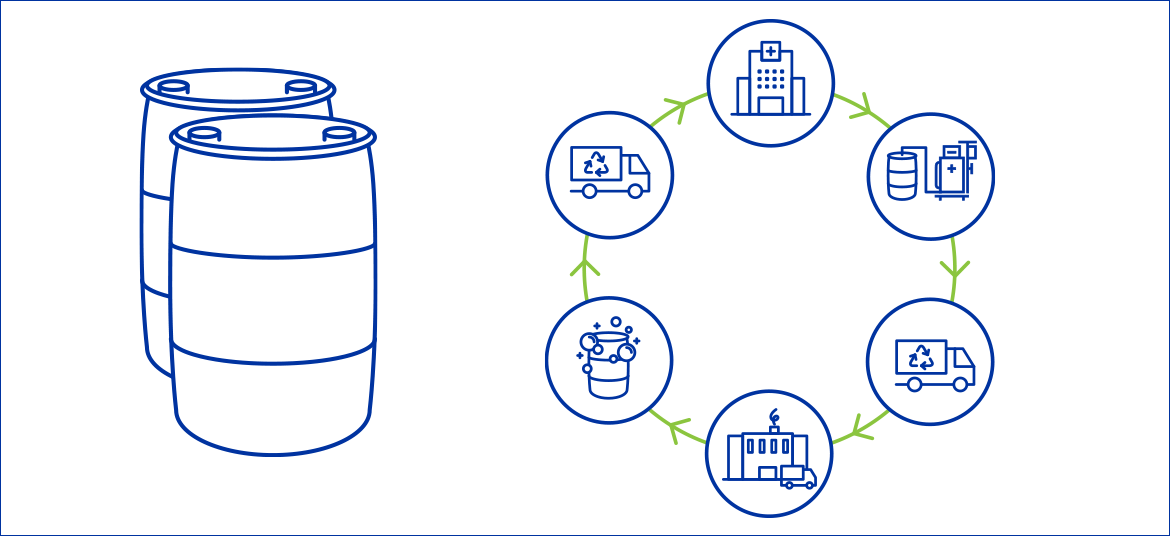
Our Blue Drum Recycling Program: A Solution to Support Environmental Sustainability
As part of our responsibility to patients, partners, and the planet, we constantly look for new and better ways to reduce our environmental impact. We identified one such opportunity in our handling of the plastic containers used to ship liquid concentrates to dialysis centers. Containers like these can take up significant space at disposal sites and emit carbon dioxide as they break down. Our goal has always been to prevent or diminish effects like these.
So, when members of our production and supply teams created a plan to reuse these large containers, they went big. They established a nationwide, closed-loop system involving manufacturing, delivery drivers, and dialysis centers, which we call the Blue Drum Recycling Program.
Now, thanks to this program, we’ve kept more than 3 million pounds of plastic out of landfills in a single year.
Blue Drum Recycling: How It Works and Why We Do It
When dialysis centers across the country receive shipments of NaturaLyte® and Citrasate® (liquid acid concentrates used during hemodialysis), they arrive in blue plastic 55-gallon drums. While these big, rugged containers are ideal for transporting liquids around the country, they can be harmful to the environment if disposed of improperly. Our Blue Drum Recycling Program extends the lifespan of each drum, allowing them to be reused approximately 60 times over several years.
Once drums are empty, they are briefly stored at our dialysis centers, then picked up and returned to one of our manufacturing facilities. There they are inspected, cleaned, refilled, and put back in circulation. This process has helped us reuse more than 141,300 drums in one year, and even drums that no longer pass inspection are sent to recycling facilities. When tabulated, this equates to a reduction of 3.1 million pounds of plastic reuse annually.
In addition to the material waste the blue drums create, plastic containers sent to landfills emit carbon dioxide as they break down. According to our Sustainability Management Team (applying information from the U.S. Environmental Protection Agency1), every reused drum is equivalent to one metric ton of carbon waste reduction. Considering the volume of barrels we recycle each year, we calculated that it would take 80.2 million trees to absorb the carbon dioxide we’re keeping out of the atmosphere.2
Reduce, Reuse, Recycle: Part of Our Corporate Culture
Bradley Mohring, director of production, Concentrates for Fresenius Medical Care Renal Technologies, says the success of the blue drum program relies heavily on cooperation from dialysis center employees, who are careful not to damage, lose, or repurpose the containers. The rate of dialysis center participation is about 95 percent.
And while the Blue Drum Recycling Program is one of our most significant environmental initiatives, we encourage sustainable ideas at all levels of the organization, regardless of scale. For example, when dialysis center employees expressed a desire to recycle cardboard and other marterials more responsibly, we distributed recycling dumpsters to approximately 250 locations. And when dialysis center nurse Jesseca Davis saw an opportunity for a more planet-friendly process, we initiated a switch from plastic cups to paper.
Managing Business More Sustainably and Responsibly
On behalf of our patients, employees, and communities, it’s critically important that we identify responsible waste disposal practices — whether handling 55-gallon drums, cardboard boxes, or one-ounce cups. These initiatives can serve as model programs for all, as we expand the ways we practice sustainability and protect the environment.
The Blue Drum Recycling Program and all of our environmentally conscious efforts are a vital part of our company’s dedication to corporate responsibility and our desire to make the world a cleaner, safer place.
- Greenhouse Gas Equivalencies Calculator. U.S. Environmental Protection Agency. March 2021. epa.gov/energy/greenhouse-gas-equivalencies-calculator.
- Data on file, Fresenius Medical Care North America Sustainability Management Team.
View the full infographic by clicking on the image


